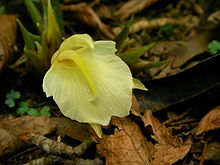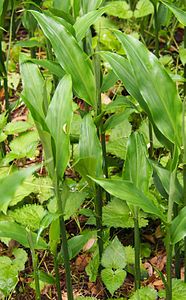Myoga: Difference between revisions
not a stub now, I think |
SimeonManier (talk | contribs) |
||
| (32 intermediate revisions by 24 users not shown) | |||
| Line 1: | Line 1: | ||
{{Short description|Species of flowering plant}} |
|||
{{For|the Inuyasha character| |
{{For|the Inuyasha character|Myoga (character)}} |
||
{{taxobox |
|||
{{Redirect|Japanese ginger|the ginger used in Japanese cuisine|Pickled ginger (disambiguation){{!}}Pickled ginger}} |
|||
{{speciesbox |
|||
|name = Myōga |
|name = Myōga |
||
|image =ミョウガ(茗荷)(Zingiber mioga)-花 (5852495693).jpg |
|image = ミョウガ(茗荷)(Zingiber mioga)-花 (5852495693).jpg |
||
| ⚫ | |||
|regnum = [[Plantae]] |
|||
| ⚫ | |||
|unranked_divisio = [[Angiosperms]] |
|||
| ⚫ | |||
|unranked_classis = [[Monocots]] |
|||
| ⚫ | |||
|unranked_ordo = [[Commelinids]] |
|||
| ⚫ | |||
|ordo = [[Zingiberales]] |
|||
|familia = [[Zingiberaceae]] |
|||
| ⚫ | |||
| ⚫ | |||
|binomial = ''Zingiber mioga'' |
|||
| ⚫ | |||
| ⚫ | |||
| ⚫ | |||
*''Zingiber mijooka'' <small>Siebold, spelling variation</small> |
*''Zingiber mijooka'' <small>Siebold, spelling variation</small> |
||
*''Zingiber sjooka'' <small>Siebold</small> |
*''Zingiber sjooka'' <small>Siebold</small> |
||
*''Zingiber mioga'' var. ''variegatum'' <small>Makino</small> |
*''Zingiber mioga'' var. ''variegatum'' <small>Makino</small> |
||
*''Zingiber echuanense'' <small>Y.K.Yang</small> |
*''Zingiber echuanense'' <small>Y.K.Yang</small> |
||
}} |
|||
[[File:Leiden University Library - Seikei Zusetsu vol. 24, page 037 - 茗荷 - Zingiber mioga (Thunb.) Roscoe, 1804.jpg|thumb|Ginger leaves, illustration from the Japanese agricultural encyclopedia [[Seikei Zusetsu]] (1804)]] |
|||
'''Myoga''', '''myoga ginger''' or '''Japanese ginger''' ({{nihongo|'''''myōga'''''|茗荷||}}) is the species '''''Zingiber mioga''''' in the [[Zingiberaceae]] |
'''Myoga''', '''myoga ginger''' or '''Japanese ginger''' ({{nihongo|'''''myōga'''''|[[wikt:茗荷|茗荷]]||}}) is the species '''''Zingiber mioga''''' in the family [[Zingiberaceae]]. It is a deciduous herbaceous [[Perennial plant|perennial]] native to [[Japan]], [[China]], and the southern part of [[Korea]].<ref name="cloves">[http://apps.kew.org/wcsp/namedetail.do?name_id=273338 Kew World Checklist of Selected Plant Families]</ref><ref>[http://www.efloras.org/florataxon.aspx?flora_id=2&taxon_id=200028463 Flora of China v 24 p 332, <big>蘘荷</big> rang he, ''Zingiber mioga'' (Thunberg) Roscoe, Trans. Linn. Soc. London, Bot. 8: 348. 1807. ]</ref><ref name=Cole14>Cole TCH, Nürnberger S [https://www.rhs.org.uk/about-the-rhs/publications/magazines/The-Plantsman/2014-issues/december/zingiber-mioga-and-its-cultivars "Zingiber mioga and its Cultivars,"] ''The Plantsman. Royal Horticultural Society.'' December 2014, 4: 226-229.</ref> Only its edible flower buds and flavorful shoots are used in cooking.<ref>Matsuhisa, Nobu and Mark Edwards. (2007). [https://books.google.com/books?id=wPMvfj0W7isC&pg=PA252&dq= ''Nobu West,'' p. 252].</ref> The flower buds are finely shredded and used in [[Japanese cuisine]] as a garnish for ''[[miso]]'' soup, ''[[sunomono]]'', and dishes such as roasted eggplant. In [[Korean cuisine]], the flower buds are skewered alternately with pieces of meat and then are pan-fried.{{citation needed|date=May 2017}} |
||
| ⚫ | |||
| ⚫ | |||
| ⚫ | |||
| ⚫ | |||
| ⚫ | |||
==Cultivation== |
==Cultivation== |
||
| Line 34: | Line 23: | ||
As a woodland plant, myoga has specific shade requirements for its growth. It is frost-tolerant to {{convert|−16|C|F|0}}, and possibly colder.<ref name=Cole14/> |
As a woodland plant, myoga has specific shade requirements for its growth. It is frost-tolerant to {{convert|−16|C|F|0}}, and possibly colder.<ref name=Cole14/> |
||
Three variegated [[cultivar]]s are known: 'Dancing Crane', 'Silver Arrow' and 'White Feather'. They are less cold-hardy than unvariegated plants.<ref name=Cole14/> |
Three [[Variegation|variegated]] [[cultivar]]s are known: 'Dancing Crane', 'Silver Arrow' and 'White Feather'. They are less cold-hardy than unvariegated plants.<ref name=Cole14/> |
||
== Medicinal properties == |
== Medicinal properties == |
||
Myoga has shown promise for potentially [[Carcinogen|anticarcinogenic]] properties.<ref>Ha Won Kim ''et al.'' [http://www.liebertonline.com/doi/pdf/10.1089/ars.2005.7.1621 "Suppressive Effects of Mioga Ginger and Ginger Constituents on Reactive Oxygen and Nitrogen Species Generation, and the Expression of Inducible Pro-Inflammatory Genes in Macrophages,"] ''Antioxidants & Redox Signaling.'' November/December 2005, 7(11-12): 1621-1629; retrieved 2013-8-4.</ref> |
|||
==Gallery== |
|||
| ⚫ | |||
| ⚫ | |||
| ⚫ | |||
| ⚫ | |||
| ⚫ | |||
==References== |
==References== |
||
{{ |
{{Reflist}} |
||
==External links == |
==External links == |
||
| ⚫ | |||
* [http://www.4seasonsseeds.com.au/Myoga-Japanese-Ginger "Myoga" at 4seasonseeds.com.au] |
|||
| ⚫ | |||
{{Japanese food and drink}} |
|||
| ⚫ | |||
{{Ginger Plant}} |
|||
| ⚫ | |||
{{Herbs & spices}} |
|||
{{Taxonbar|from=Q1196818}} |
|||
| ⚫ | |||
| ⚫ | |||
[[Category:Flora of Korea]] |
|||
[[Category:Inflorescence vegetables]] |
[[Category:Inflorescence vegetables]] |
||
[[Category:Japanese cuisine]] |
[[Category:Japanese cuisine]] |
||
[[Category:Japanese vegetables]] |
|||
[[Category:Stem vegetables]] |
[[Category:Stem vegetables]] |
||
[[Category: |
[[Category:Zingiber]] |
||
| ⚫ | |||
| ⚫ | |||
Latest revision as of 01:47, 6 March 2024
| Myōga | |
|---|---|

| |
| Scientific classification | |
| Kingdom: | Plantae |
| Clade: | Tracheophytes |
| Clade: | Angiosperms |
| Clade: | Monocots |
| Clade: | Commelinids |
| Order: | Zingiberales |
| Family: | Zingiberaceae |
| Genus: | Zingiber |
| Species: | Z. mioga
|
| Binomial name | |
| Zingiber mioga | |
| Synonyms[1] | |
| |

Myoga, myoga ginger or Japanese ginger (myōga (茗荷)) is the species Zingiber mioga in the family Zingiberaceae. It is a deciduous herbaceous perennial native to Japan, China, and the southern part of Korea.[1][2][3] Only its edible flower buds and flavorful shoots are used in cooking.[4] The flower buds are finely shredded and used in Japanese cuisine as a garnish for miso soup, sunomono, and dishes such as roasted eggplant. In Korean cuisine, the flower buds are skewered alternately with pieces of meat and then are pan-fried.[citation needed]
Cultivation[edit]
A traditional crop in Japan, myoga ginger has been introduced to cultivation in Australia and New Zealand for export to the Japanese market.[3]
As a woodland plant, myoga has specific shade requirements for its growth. It is frost-tolerant to −16 °C (3 °F), and possibly colder.[3]
Three variegated cultivars are known: 'Dancing Crane', 'Silver Arrow' and 'White Feather'. They are less cold-hardy than unvariegated plants.[3]
Medicinal properties[edit]
Myoga has shown promise for potentially anticarcinogenic properties.[5]
Gallery[edit]
-
Plants
-
Fruits with red interiors and black seeds with a whitish aril
-
Buds prepared for sale
References[edit]
- ^ a b Kew World Checklist of Selected Plant Families
- ^ Flora of China v 24 p 332, 蘘荷 rang he, Zingiber mioga (Thunberg) Roscoe, Trans. Linn. Soc. London, Bot. 8: 348. 1807.
- ^ a b c d Cole TCH, Nürnberger S "Zingiber mioga and its Cultivars," The Plantsman. Royal Horticultural Society. December 2014, 4: 226-229.
- ^ Matsuhisa, Nobu and Mark Edwards. (2007). Nobu West, p. 252.
- ^ Ha Won Kim et al. "Suppressive Effects of Mioga Ginger and Ginger Constituents on Reactive Oxygen and Nitrogen Species Generation, and the Expression of Inducible Pro-Inflammatory Genes in Macrophages," Antioxidants & Redox Signaling. November/December 2005, 7(11-12): 1621-1629; retrieved 2013-8-4.
External links[edit]
 Data related to Zingiber mioga at Wikispecies
Data related to Zingiber mioga at Wikispecies Media related to Zingiber mioga at Wikimedia Commons
Media related to Zingiber mioga at Wikimedia Commons



